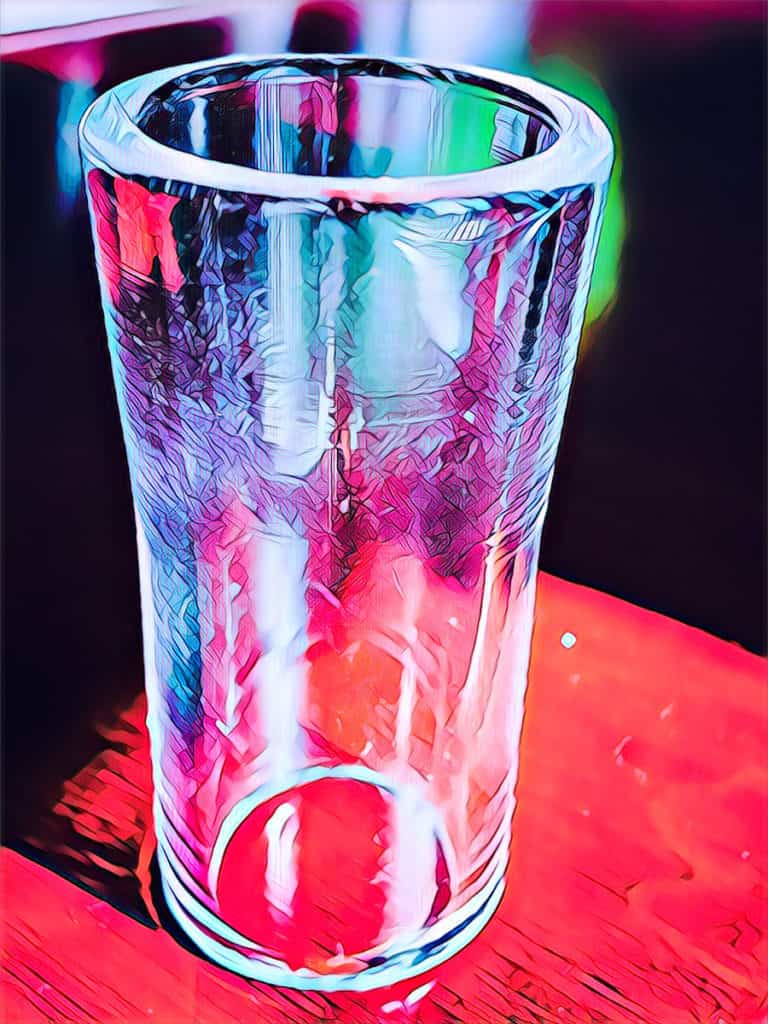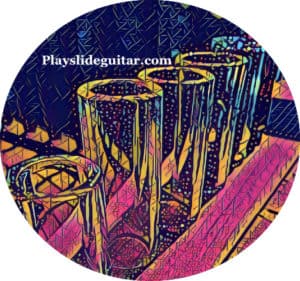As an Amazon Associate Playslideguitar.com earns from qualifying purchases. This page contains affiliate links.
When playing slide guitar, the type of slide you use can shape the sound you create. The tone you get will often be influenced by the slide’s material, size, diameter, and the type of guitar you use it with.
Almost any slide you use will create a unique timbre for guitar, and give you a lot of options for expression. You’ll want to use one that is comfortable, and provides the sound that you’d like to voice through the instrument.
Taking a closer look at the options helps in determining which slide to use for various playing styles and musical applications…
- Size and Shape
- Flared or Tapered Slides
- Glass Slides
- Metal Slides
- Porcelain, Ceramic, and Ebony Slides
- Bottleneck Slides
- Slides vs. Bars
- A Collection of Slides
Size and Shape
From a technique standpoint, finding a slide that is comfortable on your finger and fits well will be very beneficial. If you can more efficiently control the slide as you play, then you’ll have more flexible options for expressing sound.
Here’s what to look for…
Diameter
The diameter of the slide, as well as the size of your finger that you hold it on, will play a large role in how comfortable it feels and your ability to use it more effectively.
Some brands offer a sizing method that allows you to determine your ring size, which you can use to find a slide that has a good fit for you.
No matter how you discover the diameter you’d like to use, keep in mind that you usually want a slide that isn’t too tight, and not too loose: you’ll want it to be comfortable while not losing too much control over it. With a little bit of “wiggle room” in the slide, your finger can relax and still have enough tension to sustain notes and make versatile movements along the fretboard.
Try different sizes on, and use different sizes as you play, to get a better feel for what diameter slide works best for you. This may be a trial and error process, but as you dial it in you can always remember the diameter size of the slide for down the road.

Wall Size
The thickness of the wall of the slide will be a great determinant in the tone you get, as well as the feel and control you have over the slide. The thicker the wall, the beefier and warmer the tone usually. However, a slide that has too thick of a wall may sound too dull and undefined for the tone you’d like to hear.
On the other hand, a thinner wall may provide more mobility and have a lighter feel to it, but the tone will probably be brighter and more thin. This isn’t necessarily a bad thing, as this can be great for certain musical applications, but try not to sacrifice too much tone by not having enough wall thickness.
Guitars that have heavier string gauges, or require more sustain and force to play, can benefit from having a thicker wall size. If you’re playing electric guitar with thin string gauges, then a smaller wall size may be more appropriate.
Length
Although the length of the slide is influential to how it feels on your finger, it also impacts the amount of strings you can play at once in a comfortable manner. Since most slide guitars will have six strings, many slides will be long enough to cover all six at once.
However, if the way your slide rests on your finger while your playing makes it too short to cover all of the strings, then you may need to use a longer slide. Most of your playing won’t involve playing all the strings at once, so there isn’t a huge need to fret over this, however you’ll want this option if you so desire.
Also, if a slide is too long or short in length, then it may feel uncomfortable and be harder to control as you play. Try to find a slide that feels good on your finger, and has just the length you need for playing the strings that you’d like to. If it is way shorter or longer than this, then it will probably hinder your movement and playing abilities.
Flared or Tapered Slides for Guitar
Some slides are designed with a flared edge to affect the string contact, and also to compensate for guitar fingerboards that are curved or have a radius to them.
Although most regular slides will work just fine for many guitars, you may find certain applications for a flared slide where the physical aspects of it are beneficial. Also, some players find that it is more comfortable to use.

However, keep in mind that it may be harder to control in some ways, and you may lose the ability to create an even balance with the slide against the strings for sustain and vibrato.
Dunlop’s 232 Harris brass slide (link to Amazon) is a nice option if you’re looking for a tapered slide that is made from solid brass. Also, because it is tapered, you’ll have different options for the way you control the slide compared to using a regular slide.
Guitar Slide Materials: Glass, Metal, and More
Since there are many different types of slides, it can be nice when you find one that feels good and provides a certain tonality that you’re looking for in your playing. Experimenting with various slides is an enjoyable process, and as you begin to discover ones that are worth keeping in your collection, it’ll be nice to have more tonal options for your music.
One of the first things to consider when choosing a slide is the material it is made out of, which will affect the sound greatly. Glass is very common to use, especially for electric guitar, and metal types are often used for acoustic and resonator guitars.
Check out the slides below, which can be good to use for many types of slide playing…
Glass Slides
The silky, smooth sound that glass can provide on slide guitar is delightful and often desired by many slide guitarists. Glass also has a nice and fluid feel along the strings, which makes it great for the actual movement of sliding into notes.
Bottleneck guitar players from the early 1900s often used the ends of glass bottles as their slides, hence the term bottleneck guitar.
Before this, they often used a pocketknife and other materials. However, one thing they were probably taking advantage of is the glass slide’s capabilities to cover more strings at a time. The sound and tone that it creates was probably desirable as well.
Let’s look at some of the best options of glass slides for guitar…
Best Glass Guitar Slides
Dunlop 275 Blues Bottle Slide (available on Amazon): This slide is great for electric playing, and the heavy wall adds a warm tone to the clarity that the glass already provides. I enjoy the way this slide feels on the fingers, and it has a nice fluidity to it as you move along the fretboard.

Clear Glass Rock Slide (click to view on Amazon): Rock Slides are known for their distinct design, and can have a smooth feel along the strings. They’re good for control (can have a nice mobility along the neck), and fit well on the finger. This one has the transparent and warm tone that glass is known for.

Dunlop Derek Trucks Signature Glass Slide (link to Amazon): Another good bottleneck slide choice, the Derek Trucks model has a nice sound to it. Designed with Trucks’ slide in mind, it’s neat to experiment with the slide specs that he uses.

Dunlop 210 Glass Slide (available on Amazon): An open end standard type, this Pyrex glass slide is a good choice if you’re looking for a medium wall slide with a lighter feel.

Metal Guitar Slides
Stainless Steel
Slides that are made out of stainless steel can be great to use for electric, acoustic, lap, and resonator guitars. They will provide a full and broad sound, that projects well. Although they may lose a little bit of the warmth that glass slides provide, they can still have a nice rounded sound with a hint of brighter tones.
A lot of lap steel and pedal steel bars are made out of stainless steel as well, as the versatility of the material is great for many forms of playing. Many players prefer to use metal slides on acoustic guitars, and glass slides on electric. However, both can be used interchangeably.
Stainless steel slides can often have an edgier and more metallic tone to them than glass slides, and it can be nice to have both types for various musical situations. You may find that stainless steel or metal slides are more durable and rigid for creating sustain, and that glass slides are more sensitive (and may require more delicacy when used in some circumstances).
Chrome Slides
Very similar from a feel and technique standpoint to stainless steel slides, chrome slides can produce a slightly warmer tone than their steel counterparts. Chrome can also sometimes feel smoother against the strings, which may provide more flexibility in movement along the strings.
If you’re playing a style of music where you want a warmer tone, or you’re playing acoustic, chrome can be a great option to try out. Chrome can also work well with electric slide guitar applications, and you may enjoy the full and brighter tone of it, in comparison to using glass.
Brass Slides
Using a brass slide is another option in the metal department, and it can provide a warmer sound than some of the other metallic slides.
These can have a certain depth to their sound, and more vintage tone to them, and are enjoyable to use with resonator guitars and acoustic. You may find good uses for it on electric guitar as well.
Best Metal Guitar Slides
There are a lot of metal slide options for guitar, but here are some good ones to check out…
Dunlop 220 Chrome Steel Slide (link to Amazon): With a lighter feel compared to some other metal slides, this slide will provide a good amount of sustain and have an edgier sound than glass. It’ll maintain some warmth with the chrome, however it will have a brightness and projection that makes it nice to use for acoustic or electric.

MagSlide Magnesium Guitar Slide (available on Amazon): Made from one of the lightest metals, this slide is even lighter than a lot of glass slides, yet it’ll still provide enough sustain and warmth. It also has grooves on the inside of the slide for a better grip.

D’Addario Rich Robinson Brass Slide (link to Amazon): This one is a great option if you’re looking for a brass slide. Tonally it will provide a crisp and projecting tone, and keep some warmth with the brass. The inside is tapered slightly to provide more control with your finger.

Porcelain, Ceramic, Ebony, and More
There are even more material options for slides, and it can be fun to experiment with their various tones.
Porcelain may give you more warmth than metal materials, while being different enough than glass to give you a new flavor of sound. Dunlop’s 265 Keb’ Mo’ Signature slide (link to Amazon) is a good porcelain option to look at.
Ceramic slides are another option worth exploring, and may have a distinguishable timbre as you play. They can often provide a rich tone, and give you more sound possibilities for your slide playing. Check out Star Singer’s Desert slide (available on Amazon), which is a handcrafted ceramic slide from Gladstonbury, UK.
Ebony guitar slides like Taylor’s Ebony Slide (link to Amazon) can be a great choice for acoustic guitar, as the ebony will help create a nice warm and rounded tone. It is a soft material that will have a more graceful sound to it.
Bottleneck Slides
Slides that are closed on one end, and resemble the end of glass bottles, are often called bottleneck slides. These are a favorite among many slide guitar players, and the slide guitar tradition has is greatly influenced by this type of slide.
The closed end may provide a difference in feel and control for some players’ technique, and the open end where the finger is placed into is often a bit smaller than the closed end (this usually doesn’t mean the slide is flared however).
Experimenting with the bottleneck type of slide is usually a must for any slide player, but you may ultimately decide that other slide types are more beneficial for your sound and technique.
There are many players who find the bottleneck shape and material to be the most comfortable type to use. Bottleneck glass slides have a wonderful tonality for electric guitar, and can provide a nice and creamy sound that has plenty of definition, clarity, and warmth to it.
Check out the Amber Glass Rock Slide (available on Amazon) if you’re looking for more glass bottleneck slide options for your collection. It’s a hand molded slide and the amber will have a neat tonality to it.
Slides vs. Bars
Most slides are going to be a hollow and cylindrical object, allowing you to put your finger within it. However, bars are commonly used for steel guitar playing, especially when a lap steel or pedal steel is used.
Slides provide more mobility and control for upright playing, which is why being able to put your finger within it is beneficial.
In the earlier days of bottleneck and slide traditions, players attached an object to their finger with materials such as a rubber band to hold it firmly against their finger. Putting their finger within a slide or object reduced this need, and gave players more control and flexibility for their slide playing.
Bars are great to use when playing guitars in a flat, horizontal manner, like a steel guitar on a player’s lap (often called a lap steel) for instance. Because a downward force is applied for sustain, a player controls the bar without a need to place their finger within an object, and gravity naturally helps hold the bar evenly across the strings.
Playing with a bar on an upright guitar becomes impractical, and controlling a bar for horizontal playing is certainly different from a technique standpoint than slide guitar playing.
A Collection of Slides
Most slide players will have multiple slides that they use for various musical applications. It can be nice to have tonal options for different styles of music, as well as for playing an assortment of guitars that you may be using the slides on.
Having a cache of slides is a great musical toolbox to have, and the relatively low cost of most slides makes acquiring a collection much easier for many players.
Many slide players will own a bottleneck glass slide, a steel slide, a brass slide, and a regular glass slide. These options can be great for live and studio settings, or even just to experiment with, and can be helpful in determining which slides work best for you.
For playing tips and advice on using a slide, click below…
